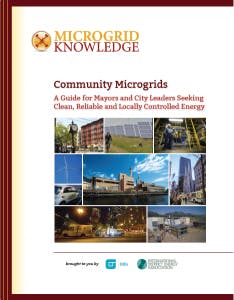The value of a microgrid lies in its sophisticated ability to offer cost-effective solutions customized to a community’s energy needs. So while the technology is proven, it is not as simple to develop as say, installing back-up diesel generators or solar panels.
Therefore, it is important that municipal leaders engage energy experts early in the planning process, so that they can configure a microgrid that cost-effectively meets the community’s unique energy requirements.
Microgrids are suited to today’s constrained municipal budgets, in that microgrids are modular so can be developed incrementally. A community may begin small with minimal investment and then gradually expand, adding more generators, an expanded thermal grid, and customers over time.
Communities sometimes build all new infrastructure for a microgrid. But it may be easier and more cost-effective to configure a microgrid around existing energy facilities, such as a CHP plant that may already serve a local hospital or college.
Future promise
Microgrids are a niche technology. But energy experts increasingly envision a future where microgrids and other forms of distributed energy come to dominate the U.S. grid. They see such a grid as more nimble, competitive, price-responsive and safe from physical or cyberattack. This model puts control of energy more in the hands of consumers and communities.
Before microgrids can achieve this promise, state regulation and policy will need to catch up with new energy technology. This lag in government policy creates challenges to microgrid advancement. As a result, community leaders may find themselves grappling with some of the following issues as they develop microgrids.
Two key challenges
1. How to compensate microgrids fairly
Microgrids create a new exchange of value on the grid that has yet to be monetized. It’s agreed that power outages are costly to society. Microgrids help avert outages and create oases of electricity and shelter during a crisis. How should a microgrid owner be compensated for this service to society?
Kenneth Horne, associate director at Navigant Research, summed up the issue this way, in a presentation he made at the Third National Conference on Microgrids in Dallas, Texas in April 2015:
Credit: David Shankbone
“If you are a Walmart or a Walgreens or a gas station at the time when the grid is out, you are doing more than simply selling things to customers for a profit. You are providing essential community services for citizens who have no place else to go—whether you are providing milk for a mother who has to feed her young child, or you are providing food (something most of us take for granted on a day-to-day basis) or other kinds of supply, material, perhaps shelter, perhaps warmth. The basic essential needs that we all have as human beings—that we are blessed not to have to think about on a daily basis—suddenly become the center of our lives.”
2. How to manage the utility relationship
Forward-thinking utilities support the idea of microgrids and some are developing microgrids of their own. But others see microgrids as competitors. Your utility’s pre-disposition makes a difference since it can affect the ease with which your project becomes interconnected with the grid during development.
Three main points of contention sometimes occur between utilities and microgrids.
- Who will pay what in the exchange of services? As the exchange of services become more complex between utilities and microgrids, it is inevitable that issues will arise about payment fairness. Standby rates already sometimes serve as a point of friction between utilities and microgrids. Utilities charge standby rates for being at the ready to supply power to distributed energy generators. The rates vary nationwide, some high and some low.
- Where can a microgrid operate? Utility franchise rights are at the heart of this issue. In many states a microgrid cannot string its wires across a utility right-of-way without utility or municipal permission. This can preclude the microgrid from serving customers that are across the street. Some states, among them Connecticut, Massachusetts and New York, are working on ways to resolve this issue and make it easier for microgrids to encompass multiple customers.
- Are utilities competitors or partners? How this issue plays out is likely to vary depending on whether or not your community is in a state where electric retail markets are regulated or deregulated, and whether or not that state is creating rules that provide incentive for utilities to support microgrids.
Utilities earn revenue by selling kWh of electricity. As a result any entity that reduces those utility sales— as a microgrid would—can be viewed as a competitive threat. As an alternative, some states have implemented “de-coupling” that shifts revenue risks somewhat and creates incentives for utility performance and efficiency in exchange for anticipated reduction in simple volumetric electricity sales.
Utilities in deregulated states cannot own power plants for the most part. So from that perspective it is easier for communities and private companies to develop microgrids in deregulated states. However, issues still may arise about ownership of distribution lines that carry the power from generators to customers and equitable cost-recovery methodologies that allow accessibility to the wires under reasonable price signals.
Credit: Wikimedia Commons
Model for the future
Microgrids are an established technology. But they interact in new ways in energy markets and provide services not before quantified. Given the value of these services, several states are trying to determine how to resolve these challenges and smooth the way for development of more microgrids and other forms of distributed energy.
State public utility commissions seek input on these changes. It’s important for mayors and city leaders to participate because they can play an instrumental role in shaping rules that foster community microgrids. A mayor seeking an economic development advantage by offering a more resilient, clean energy microgrid to attract a high value pharmaceutical research/manufacturing campus will want regulators to enable reasonable rules for microgrid deployment and optimization.
California, Connecticut, Maryland and Massachusetts are among those that are exploring various innovations. But New York is the most closely watched because it is proposing an entire remaking of electric markets and rules that is expected to lead to significant development of microgrids and other forms of distributed energy.
Called Reforming the Energy Vision, or REV, New York’s approach does more than just address the problems that can stymie microgrid development. Instead, it remakes the utility’s entire role.
REV attempts to animate markets that foster distributed energy. The utility becomes a new entity, the distributed system platform, a kind of impartial distributed grid manager that ensures use of the most efficient and cost-effective mix of retail energy. In this new role, utilities no longer depend on kWh sales for revenue, but are paid for their services in managing the platform. Unable to own microgrids, except under limited circumstances, the utility does not directly compete with the private or public entities that develop microgrids.
New York has already taken steps toward putting REV in place, but many rules are still being developed. The proceeding is ongoing before the New York Public Service Commission, Docket 14-M-0101.
State rules are likely to evolve for years to come as energy consumers increasingly turn to microgrids and distributed energy. In place for over a century, the structure for energy delivery is radically changing in the U.S. The consumer and community no longer need to be passive recipients of energy, but can be active players who manage how much and what kind of energy they use. Communities do not have to wait for a final resolution of government policy to become part of this change. Indeed, many towns and cities are already moving forward with microgrids.
Credit: Veolia North America
Where to start
In its report, “Community Microgrids: Smarter, Cleaner, Greener,” the Pace Energy and Climate Center outlines the following eight steps to follow in developing a microgrid.
- Set project goals. Is the goal to maximize reliability? Cost savings? Business growth? Should the project be built in phases?
- Organize, educate core stakeholders. Who are the potential champions, stakeholders and authorities who will have a say in this process? Should a steering committee be appointed? How can these parties be educated and organized?
- Identify project site. Where are reasonably large pockets of consistent energy demand? Are there large energy users in these pockets who can anchor a project?
- Conduct 1st level screening study. Is this project technically feasible? Is this site appropriate?
- Conduct 2nd level screening study. What are the project site’s daily and sub-hourly energy demands? What will be the capital costs and returns on investment?
- Conduct audit grade study. What will the business model, ownership structure, tax treatment, and payback period of this project look like? How thoroughly must the technical viability of the project be demonstrated in order to attract financing?
- Acquire financing. Will bonds, equity, leasing, third party ownership or some other type of financing work best for the project?
- Acquire necessary approvals and construct. Will this project require zoning variances? Building permits? Revocable consents? Excavation permits?
It’s also helpful for city leaders to gain a basic understanding of how electric competition works, especially in the organized power markets that serve about two-thirds of the U.S. population. Rules vary within these markets and some make it easier than others for microgrids to earn revenue by selling ancillary services to the grid.
To read the rest of this article series now, go to “Community Microgrids: A Guide for Mayors and City Leaders Seeking Clean, Reliable and Locally Controlled Energy,” available as a free download, courtesy of the International District Energy Association (IDEA) and OBG. Or visit EnergyEfficiencyMarkets.com next week.
Note: This is the fourth article in our series on community microgrids. See our first three articles:










